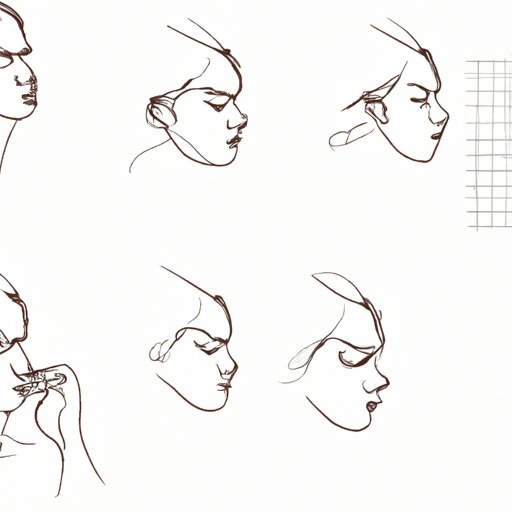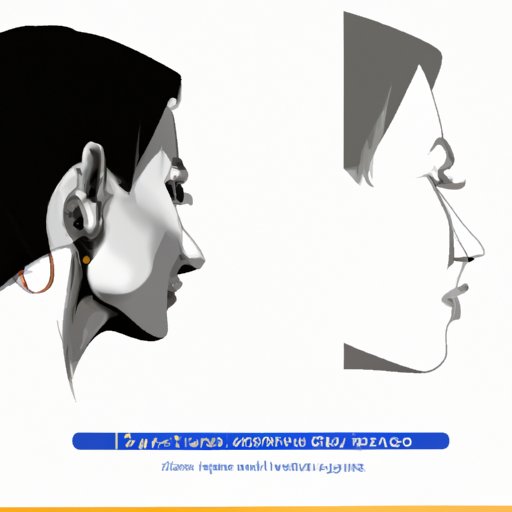
I. Introduction
Side profile drawing can be a challenging skill to master, especially for beginners. Creating a realistic side profile drawing requires understanding the basic head shape and proportions, as well as the intricate details that make a person unique. But it is an essential skill for any artist, whether you are an aspiring professional or just looking to create a portrait of a loved one. In this article, we will guide you through the step-by-step process of drawing a side profile, discussing tips, tricks, and common mistakes to avoid.
II. Step-by-Step Guide to Drawing a Perfect Side Profile
To draw a side profile, you need to start by understanding the ideal head shape and proportions. The human head is shaped like an oval, with the face as the front part of the oval. The center line of the oval is where the nose starts, and the ears sit on the sides of the head. Use this as your guide for the basic shape of the head.
Start by drawing an oval shape, placing the center line where the nose will be. Then, add the chin, jawline, and ears. Remember that the ears sit behind the face, so only a small portion of them will be visible in a side profile drawing.
Once you have your basic head shape, it’s time to add the details. Start with the nose, drawing in the nostrils and bridge. Then, add the mouth and lips, followed by the eyes. The eyes should sit on the horizontal center line of the head, and the eyebrows should follow the shape of the eye socket.
Finally, use shading and hatching techniques to add depth to your drawing. Study the different tonal values of shadows, and use an eraser to create highlights. Work with different pencil grades to add variety to your shading.
III. Mastering the Art of Side Profile Drawing
The key to mastering side profile drawing is to practice regularly. Drawing from life is always the best way to improve, so try to find a willing model or use reference photos to guide your drawings. You can also work on understanding the different face shapes and features, which will help you create more realistic drawings.
Here are a few tips for improving your skills:
1. Study the work of famous artists, taking note of their techniques and styles.
2. Break down complex facial features into basic shapes, then work on adding details.
3. Experiment with different drawing materials, such as charcoal or ink, to add variety to your work.
IV. Tips and Tricks for Drawing Side Profiles Like a Pro
To draw side profiles like a pro, it’s important to observe real-life objects and other references. Look at your own face in the mirror, or study photographs of people at different angles. Pay attention to how the light falls on their faces, and how the shadows create depth and contrast.
Other tips for drawing side profiles include:
1. Understanding the direction of the light source, and how this affects the shadows on the face.
2. Mastering facial hair, including beards and mustaches, which can add character and detail to a drawing.
3. Learning the intricacies of different face shapes, such as square, round, or triangular.
V. The Importance of Proportions in Side Profile Drawing
Creating a realistic side profile drawing requires understanding the basic facial proportions. This includes the placement of the eyes, nose, and mouth, as well as the shape and size of the head. An incorrect proportion can make a drawing appear unrealistic, so it’s essential to get them right.
Here are some guidelines for achieving correct facial proportion:
1. The eyes should be at the halfway point of the head, horizontally. Vertically, they should sit slightly above the centerline of the oval.
2. The bottom of the nose should align with the centerline of the head.
3. The mouth should sit roughly halfway between the nose and chin.
VI. Breaking Down the Complexity of a Side Profile Drawing
Creating a realistic side profile drawing can be challenging, especially when it comes to the different elements involved in drawing the nose, mouth, eyes, and ears.
Here are some tips on how to effectively break these elements down to make it easier for you to draw them:
1. Draw basic shapes first, and then add details gradually.
2. Pay attention to the subtle variations in tone and shadow that occur within each feature.
3. Don’t be afraid to make mistakes! The more you practice, the more confident you’ll become.
VII. Common Mistakes to Avoid While Drawing a Side Profile
Here are some of the most common mistakes people make while drawing side profiles:
1. Overemphasizing certain features, such as the nose or mouth, while neglecting others.
2. Improper placement of features, which can throw off the proportions of the face.
3. Not paying attention to tonal values, resulting in a flat or unrealistic drawing.
To avoid these mistakes, take your time and work methodically. Use reference images and guidelines to ensure you’re on the right track.

VIII. How to Add Detail and Depth to Your Side Profile Drawings
Adding detail and depth to your side profile drawings is essential to creating a realistic and engaging portrait. Here are some tips to get you started:
1. Experiment with different shading techniques, such as cross-hatching or stippling, to add texture.
2. Study how light falls on different facial features and use shading to create realistic shadows.
3. Choose the right drawing tools, such as pencils, charcoal, or ink, to achieve the desired effect.
IX. Conclusion
Drawing a side profile requires patience, practice, and perseverance. By following the tips and tricks outlined in this article, you will be well on your way to mastering this essential drawing skill. Remember to observe real-life objects and references and to understand the importance of proper facial proportions. Keep practicing, and don’t be afraid to make mistakes.




